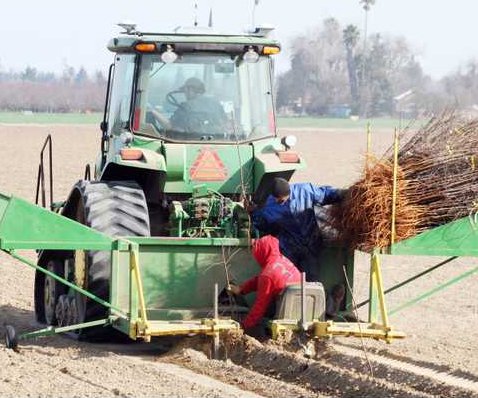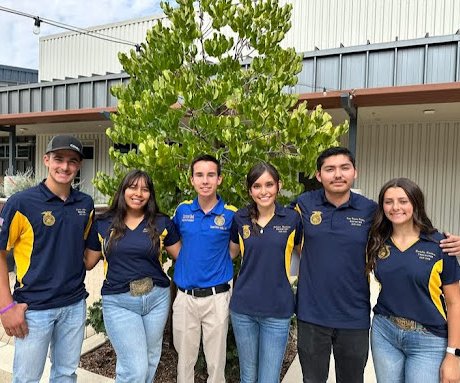By Caleb Hampton
California Farm Bureau Ag Alert
Mild temperatures in the Central Valley were kind to cling peaches this month as farmers harvested their early varieties. The balmy weather allowed fruit to size up and left few blemishes, growers said.
“So far, the quality of the fruit is looking really good,” said Chetan Khera, whose family’s Sutter County farm began harvest July 2 with its Calaveras variety before picking a block of Stanislaus peaches in mid-July. As of last week, cling peach growers were about a tenth of the way through harvest, the bulk of which happens between early July and early September.
According to the latest crop reports reflecting the 2023 harvest, Stanislaus County recorded 3,560 harvested acres of all peach varieties, generating over $37 million in crop value. In neighboring Merced County, clingstone peaches accounted for 1,275 acres and brought in more than $12 million, while freestone varieties added another $17.9 million from 1,636 acres. These figures underscore the economic importance of peach farming to the region, including communities like Newman and Gustine, where local growers and seasonal workers play a vital role in sustaining the harvest and supporting the broader agricultural economy.
Almost all California cling peaches are shipped to two canneries, with roughly 60% of the crop processed by Lodi-based Pacific Coast Producers and 35% by Walnut Creek-based Del Monte Foods. The rest of the crop is sold to the frozen fruit market.
Growers were projected to ship around 224,000 tons of cling peaches this year, the California Canning Peach Association estimated, down slightly from last year’s haul of nearly 228,000 tons. However, the association reported July 7 that early yields were down roughly 12% from initial estimates.
“We didn’t really have any full sets this year,” said Sutter County farmer Ranjit Davit, whose yield of the Stanislaus variety was down about 70% from peak production.
Kulwant Johl, who grows cling peaches in Yuba County, also reported a high-quality crop with early yields “a little less than expected.”
Thomas Gradziel, professor of plant sciences at the University of California, Davis, said two factors could explain this year’s lower yields. Extreme heat last summer “may have hurt some of our production this year” by affecting the crop’s early development, Gradziel said, which began last July for the early varieties harvested this month.
The other explanation, he said, was that a cool December, which provided ample chill hours, was followed by a warm January, prompting some buds to come out of dormancy early. Those flowers “got first dibs,” Gradziel said, “tapping into the resources of the tree more efficiently” and forming stronger fruit. Peaches from late-blooming buds may initially have seemed viable, he said, but “a lot of that fruit later aborted.”
Because peaches are vulnerable to disruptive weather year-round, Davit said, even during harvest, “you’re never sure what you have until you have the last bin out of the field.”
The availability of workers for the time-sensitive harvest is often a concern, growers said, and more so this year because of the potential impact of the Trump administration’s mass deportation campaign on California’s largely undocumented farm workforce.
“At one point, we were quite worried,” Davit said. So far, he added, “we haven’t seen too much of a problem.”
The labor pool typically tightens in August when more peach varieties are picked, winegrape harvest begins and pear season picks up.
“The real test will come when the industry hits peak delivery volume,” said Rich Hudgins, president and CEO of the peach association.
This month in Khera’s Sutter County orchard, pickers climbed ladders and rifled through foliage, filling sacks with fruit that they emptied into large bins. Piece rate for peach pickers in the Sacramento Valley increased this year to around $30 a bin, growers said, with workers typically filling between six and 15 bins in a shift.
Growers said the rising cost of labor, which accounts for about 70% of their input costs, and downward pressure on pricing from imports has squeezed their margins. During the past two decades, the state’s cling peach acreage has declined by more than half.
“It gets worse every year,” Davit said. “We can’t compete with China’s labor costs and the pricing they’re able to bring doing business in California.”
Cling peach trees are planted under contracts with canneries that last the trees’ lifetime, ensuring each piece of fruit has a buyer. Every year, usually before harvest, the peach association negotiates a price with the canneries. The system “provides transparency and comfort for the grower,” Khera said.
But as of Monday, the association and canneries had yet to agree on a price for this year’s fruit, with negotiations stalling due to “differing views of the marketplace,” Hudgins said. He said growers were asking for a small increase on last year’s price of $635 per ton. Canneries were reluctant to raise the price due to a “potential oversupply in coming years,” Hudgins said.
From the start of the pandemic through 2023, demand surged for canned fruit, leading to more cling peach plantings. With almond and walnut prices down at the time, Khera said, “people saw peaches as a good opportunity.”
Then, in 2024, demand for cling peaches slowed, leading to concerns of a looming oversupply. When last year’s plantings come into production next year, they will increase the state’s bearing acreage from 13,760 to 14,680, according to industry estimates.
“We could certainly be dealing with some oversupply issues in the next few years,” said Davit, who is the peach association’s board chairman.
Growers appeared to take stock this year of the change in fortunes, with new cling peach plantings declining by 41%, the association reported.
Meanwhile, on July 1, Del Monte filed for Chapter 11 bankruptcy, casting uncertainty over the long-term direction of the industry. The 139-year-old company said in a statement it had secured $165 million to continue its operations during a restructuring process with lenders that will involve selling most or all of its assets.
Cling peach deliveries to Del Monte “are continuing uninterrupted” this year, Hudgins said. He expressed optimism the historic brand would continue under new ownership.
Still, the bankruptcy caused concern among growers. Khera’s family has grown peaches in Sutter County since 1978, selling about half of them to Del Monte. Next year, he said, “unless somebody else steps in, we don’t know where our crop is going to go.”
Caleb Hampton is assistant editor of Ag Alert. He can be reached at champton@cfbf.com.
To read this story and other Ag Alert stories go to: https://www.agalert.com/california-ag-news/archives/july-30-2025/peach-growers-praise-quality-as-yields-dip/





